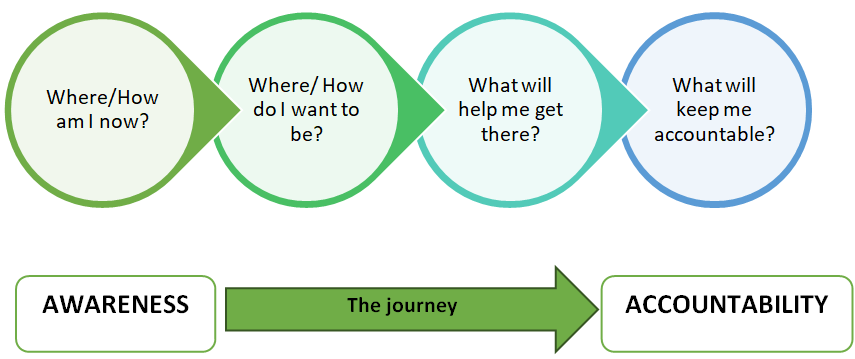A Coaching Model Created by Cristina Gutu
(Business/Career Coach, ROMANIA)


Coaching is most of the time a journey to a better self, a journey during which the client is not alone. The coach holds the client’s hand throughout the entire duration of this journey, establishes trust and intimacy, is fully present, curious and “is dancing at the moment”, listens to everything that the client is saying and not saying, supports the client in deciding what is the best destination for him and what are the best ways to get there. Also, the coach holds attention, and what is important for the client, leaves the responsibility for taking action with the client and holds him accountable.
-
Where/How am I now?
Lao Tzu said once “ The journey of a thousand miles begins with one step”.
The first step of my coaching model is becoming self-aware of your current status or situation. Knowing yourself as you are in the first step you can take in your journey towards growth and success. This is because you cannot change what you are not aware of.
Understanding your values (what defines you and how you relate to the outside world and the other people) is a key element of the coaching process and the primary focus of our journey. In our journey, your values will be our reference, they will be our tools for getting the direction right, they will be like the map and compass. They will support us in traveling forward even when storms will pass our way.
Examples of enablers that might be used at this stage:
Wheel of Life Exercise
Commonly used by professional coaches, the Wheel of Life is a great tool to help clients improve life balance as it can quickly and graphically identify the areas in their life they want to devote more energy and focus and those where they might want to cut back.
The tool is called the “Wheel of Life” because each area of your life is mapped on a circle, like the spoke of a wheel. Created by Paul J. Meyer, founder of Success Motivation® Institute, the Wheel of Life diagram enables you to plan the amount of time you will give to each area of your life based on your values, vision, and priorities at the moment.
This is an example taken from the Co-Active Coaching Toolkit:

Values Clarifications Exercises
In coaching, the client must set goals that are in alignment with their values. This is to ensure success. If we think of the journey metaphor.. think what would have happened if you had a broken compass or a wrong map… will you be able to reach the desired destination?
Very few of the coaching clients will have a clear vision of their life or their goals and a keen sense of their values. Coaches can use a multitude of visualization exercises or invite their clients to meditate to get clarity on this important aspect of their lives.
Using powerful questions
Observation and feedback
Feedback helps the client to realize that the coach’s listening is complete and real.
-
Where/ How do I want to be?
This is the goals/ objectives setting part of the journey, it is about getting clarity on the destination. This stage aims to tap into the personal values that underpin the client’s desires and create some clarity around what they want to achieve. Remember! It will always be about the client’s goals… not the coach’s goals! The coach is only a companion on this journey.
Example of powerful questions that the coach can use at this stage:
-
What will help me get there?
According to https://positivepsychology.com, there are three key things needed to achieve any goal:
A coach can support the client at this stage by his ability to create opportunities for learning, by exploring the different options that the client may not be able to see by himself and by partnering with the client in developing a step by step plan that can enable the client to achieve his goals within the desired timeframe.
Example of powerful questions that the coach can use at this stage:
-
What will keep me accountable?
Once the coach supported the clients in designing their goals, objectives, and actions to reach them, it is fundamental that he continues to stand by them and support them in achieving success by holding them accountable for their actions. Ensuring that they DO what they said they WOULD DO completes an effective coaching process
Powerful questions are again a very useful technique of creating accountability for your clients. Here are a few examples:
References:
ICA learning support documents
https://positivepsychology.com/life-coaching-questions/
Sir John Whitmore – Coaching for Performance (5th edition)